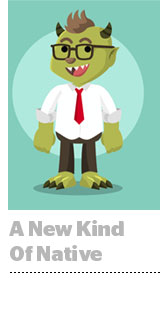
Monster considers itself a challenger brand. The early leader in the online job space commands high awareness among older job-seekers. Unfortunately, millennials are more likely to think of Monster as an energy drink.
When its VP of performance marketing and media, Brian Costello, joined Monster a year ago, he wanted to switch the thinking of his team from clicks to broader brand metrics. One way he did that was by revamping its native ad program.
Monster previously allocated fairly large spend to content recommendation engines, which distributed content created by its in-house team. The content performed well for clicks.
But Costello nixed the program, concerned about being adjacent to low-quality clickbait.
“Our goal is not click-throughs. It’s brand recognition,” Costello said. “This is an issue of where your brand fits and who it sits next to. And I don’t know if [content recommendation engines] bring any value of good brand feelings for the job-seeker.”
Instead, Monster decided to focus on what Costello views as true native: sponsored content that lives on the publisher’s site. In Q3 and Q4 of 2016, it set up sponsorship-style deals with larger portals and publishers like PopSugar. It also worked with Nativo, which gave it access to a large network of publishers, including highly relevant fits such as Entrepreneur.
Native as a channel drove the strongest results for Monster’s brand awareness, according to a study by MillwardBrown Digital, which focused on aided awareness, brand favorability, recommendation intent and use intent.
Within its group of native partners, Monster saw the strongest results with Nativo, due in part to Monster following the vendor’s instructions to test multiple versions of headlines. The tactic paid off for Monster’s team, creating a ripple effect throughout Monster’s marketing organization.
It led the organic social team, for example, to start testing its content with more regularity. The best-performing paid content stories inform planning for future organic content.
“The organic social team had been choosing just one thing and going with it. But sometimes, it goes back to ‘the best creative is the one you hate,’” Costello said.
But test-driven content creation also requires creative and media teams to talk to each other. When he joined, Costello had implemented a reorganization that brought the media team and broader marketing and content teams into closer communication – one reason he thinks Monster was able to seamlessly set up a native campaign with a test-driven approach.
“There is so much on the programmatic media side that plays into creative,” Costello said. “At large companies, you get the media folks and brand and content people on different floors that never talk.”
While Costello tries to balance the art and science of content-driven marketing, Monster’s team also uses deep attribution models to better understand the impact of its branding campaigns, rather than solely looking at the last click before a signup. The team knows when someone saw a native ad, navigated to Monster’s site and disappeared before signing up as a member.
Being able to connect the dots between top-of-funnel brand marketing and how it impacts Monster’s brand awareness has made Costello even more bullish on native advertising.
Since the initial campaign, Monster expanded its native program to other campaigns beyond the one targeting millennial job-seekers. And Costello would like to try native to recruit employees, which is the other marketing target for Monster’s business.
As the new campaigns roll out, Costello continues to urge his team to think not in terms of clicks but signs of engagement, such as scroll time and depth, and how the campaigns move brand metrics.
This post was syndicated from Ad Exchanger.

More Stories
M+AD takes break for Anzac Day commemoration
Sustainability Is More Than a Big Leafy Green Picture
Google Won’t Pull Cookies In 2024